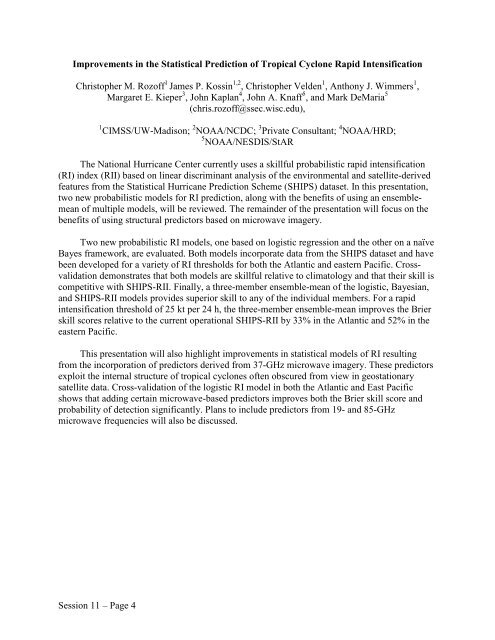65th IHC Booklet/Program (pdf - 4.9MB) - Office of the Federal ...
65th IHC Booklet/Program (pdf - 4.9MB) - Office of the Federal ...
65th IHC Booklet/Program (pdf - 4.9MB) - Office of the Federal ...
You also want an ePaper? Increase the reach of your titles
YUMPU automatically turns print PDFs into web optimized ePapers that Google loves.
Improvements in <strong>the</strong> Statistical Prediction <strong>of</strong> Tropical Cyclone Rapid Intensification<br />
Christopher M. Roz<strong>of</strong>f 1 James P. Kossin 1,2 , Christopher Velden 1 , Anthony J. Wimmers 1 ,<br />
Margaret E. Kieper 3 , John Kaplan 4 , John A. Knaff 5 , and Mark DeMaria 5<br />
(chris.roz<strong>of</strong>f@ssec.wisc.edu),<br />
1 CIMSS/UW-Madison; 2 NOAA/NCDC; 3 Private Consultant; 4 NOAA/HRD;<br />
5 NOAA/NESDIS/StAR<br />
The National Hurricane Center currently uses a skillful probabilistic rapid intensification<br />
(RI) index (RII) based on linear discriminant analysis <strong>of</strong> <strong>the</strong> environmental and satellite-derived<br />
features from <strong>the</strong> Statistical Hurricane Prediction Scheme (SHIPS) dataset. In this presentation,<br />
two new probabilistic models for RI prediction, along with <strong>the</strong> benefits <strong>of</strong> using an ensemblemean<br />
<strong>of</strong> multiple models, will be reviewed. The remainder <strong>of</strong> <strong>the</strong> presentation will focus on <strong>the</strong><br />
benefits <strong>of</strong> using structural predictors based on microwave imagery.<br />
Two new probabilistic RI models, one based on logistic regression and <strong>the</strong> o<strong>the</strong>r on a naïve<br />
Bayes framework, are evaluated. Both models incorporate data from <strong>the</strong> SHIPS dataset and have<br />
been developed for a variety <strong>of</strong> RI thresholds for both <strong>the</strong> Atlantic and eastern Pacific. Crossvalidation<br />
demonstrates that both models are skillful relative to climatology and that <strong>the</strong>ir skill is<br />
competitive with SHIPS-RII. Finally, a three-member ensemble-mean <strong>of</strong> <strong>the</strong> logistic, Bayesian,<br />
and SHIPS-RII models provides superior skill to any <strong>of</strong> <strong>the</strong> individual members. For a rapid<br />
intensification threshold <strong>of</strong> 25 kt per 24 h, <strong>the</strong> three-member ensemble-mean improves <strong>the</strong> Brier<br />
skill scores relative to <strong>the</strong> current operational SHIPS-RII by 33% in <strong>the</strong> Atlantic and 52% in <strong>the</strong><br />
eastern Pacific.<br />
This presentation will also highlight improvements in statistical models <strong>of</strong> RI resulting<br />
from <strong>the</strong> incorporation <strong>of</strong> predictors derived from 37-GHz microwave imagery. These predictors<br />
exploit <strong>the</strong> internal structure <strong>of</strong> tropical cyclones <strong>of</strong>ten obscured from view in geostationary<br />
satellite data. Cross-validation <strong>of</strong> <strong>the</strong> logistic RI model in both <strong>the</strong> Atlantic and East Pacific<br />
shows that adding certain microwave-based predictors improves both <strong>the</strong> Brier skill score and<br />
probability <strong>of</strong> detection significantly. Plans to include predictors from 19- and 85-GHz<br />
microwave frequencies will also be discussed.<br />
Session 11 – Page 4
















